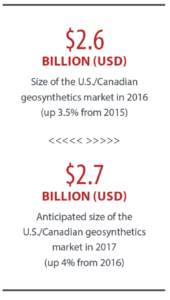The U.S./Canadian geosynthetics market includes geotextiles, geomembranes, geogrids, geosynthetic clay liners, drainage materials, geocells, and erosion control materials. In 2016, the size of the U.S./Canadian geosynthetics market was $2.6 billion, up 3.5% over 2015. It is expected to swell to $2.7 billion in 2017, up 4% compared to 2016. In a survey of Geosynthetic Materials Association (GMA) members and nonmembers in October 2016, respondents reported they expect sales to be somewhat better in 2017 than in 2016.
Highlights cited in the survey
Due to a strong U.S. dollar in 2016–2017, coupled with subdued growth in economies across the globe, U.S. geosynthetic manufacturers will likely experience staunch competition for sales due to more inexpensive imports coming into the United States.
The Water Infrastructure Improvements for the Nation (WIIN) Act was passed by Congress and was signed into law by President Barack Obama on December 16, 2016. The WIIN Act is comprehensive legislation designed to address the needs of U.S. harbors, locks, dams, flood protection, and other water resource infrastructures vital to America’s economic growth, health, and competitiveness.
The WIIN Act is a law that includes the new Water Resources Development Act (WRDA) of 2016, which President Obama signed into law on December 19, 2016. Its provisions are designed to improve drinking-water infrastructure around the country, address control of coal combustion residuals, improve water storage and delivery to help drought-stricken communities, address federal dam maintenance backlogs, and approve long-standing water settlement agreements for the benefit of taxpayers and Native Americans. The WIIN Act is the result of negotiations between the House and the Senate; it improves integral infrastructure across the U.S. and strengthens the economy.
The WIIN Act also includes Section 1173 titled “Study on Performance of Innovative Materials.” With respect to water resources development projects, innovative materials include “high-performance concrete formulations, geosynthetic materials, advanced alloys and metals, reinforced polymer composites, including any coatings or other corrosion prevention methods used in tandem with such materials.”
The innovative materials section continued: “The Secretary of the Army will offer to enter into a contract with the Transportation Research Board of the National Academy of Sciences to develop a proposal to study the use and performance of innovative materials in water resources development projects carried out by the U.S. Army Corps of Engineers.
“The study shall identify:
- conditions that result in the degradation of water resources infrastructures.
- capabilities of innovative materials in reducing degradation.
- recommendations on including performance-based requirements for the incorporation of innovative materials into the Unified Facilities Guide Specifications.
- recommendations on how greater use of innovative materials could increase the performance of an asset of the Corps of Engineers by extending its service life.”
This section concluded: “Within two years after the passage of the WIIN Act in December 2016, the Secretary of the Army will submit a report to Congress describing the results of the Study on the Performance of Innovative Materials.”
Prior to the WIIN Act, the U.S. Environmental Protection Agency (EPA) was solely responsible for implementing regulations for coal-combustion residual (CCRs or “coal ash”) units across the United States; their role has been modified under the WIIN Act. The WIIN Act now allows for a federal administrator to approve state programs for the regulation of CCR units.
 Any state that wants to administer CCR regulations must submit to a federal administrator evidence of a permit program (or other system of prior approval and conditions) under state law for the regulation of CCRs. Once the federal administrator approves the permit, the enforcement of the regulation of CCR units are executed by the state where the units reside.
Any state that wants to administer CCR regulations must submit to a federal administrator evidence of a permit program (or other system of prior approval and conditions) under state law for the regulation of CCRs. Once the federal administrator approves the permit, the enforcement of the regulation of CCR units are executed by the state where the units reside.
The enforcement of regulations of CCR units by any state that is approved for a state permit program by a federal administrator replaces the Code of Federal Regulations normally implemented by a federal administrator. If any states do not want to be the enforcer of regulations for coal combustion residual units residing in its state, then a federal administrator becomes responsible for implementing CCR regulations for such states under part 257 of title 40 of the Code of Federal Regulations.
Other highlights in the U.S./Canadian geosynthetics market in 2016–2017:
increase in growth of the geosynthetics market through continued industry efforts to improve and promote the benefits of geosynthetic usage to state departments of transportation (DOTs).
continued efforts to educate civil engineers about the benefits of geosynthetic usage compared to traditional building materials.
The value of public highway, street, and related work by state DOTs and local governments decreased by almost 2% in 2016; it is expected to decline by 1% in 2017.
The public bridge and tunnel construction market is expected to decline by 1% in 2017 to $32.9 billion—down from a record $33.3 billion in 2016.
Public transit and rail construction is expected to grow from $19.3 billion in 2016 to $20.3 billion in 2017, a 5% increase.
The value of airport construction will grow slightly in 2017—growing from $13.1 billion in 2016 to $13.2 billion in 2017—almost a 1% increase.
Jeffrey C. Rasmussen is the market research manager at the Industrial Fabrics Association International (IFAI).
Editor’s Note
In the first quarter of every year, the IFAI market research manager produces a document that describes the “State of the Specialty Fabrics Industry.” The geosynthetics section of that market report is excerpted here.
 TEXTILES.ORG
TEXTILES.ORG


